Dictionary of Vexillology: C (Cord (original) (raw)
CORD(S)
A length of decorative string or rope made from several twisted strands with tassels at each end, generally made of silk (or a silk-like material) in the livery or national colours (or gold/silver thread), simply knotted or tied a bow at the centre and used to decorate a staff (usually) just below the finial – especially (but not exclusively) that of a parade flag or military colour ‘aiguillette’, (see also ‘colour 2)’, ‘cravat 1)’, ‘finial’, ‘lanyard 1)’, ‘livery colours’, ‘national colours 2)’, ‘parade flag 2)’, ‘staff 2)’ and ‘tassels’).
As above but without tassels and used to finish the edges of a flag, usually in the livery or national colours (or gold/silver thread).

Ceremonial Flag of Abedim-Moncao, Portugal (fisisco)
CORDED CROSS
See ‘roped cross’.
CORDS AND TASSELS
See ‘cord(s) 1)’ and ‘tassels’.
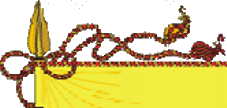
Ceremonial Flag of Abedim-Moncao (detail), Portugal (fisisco)
CORE FLAG
The flag whose design forms the basis of other flags, or which inspired the creation of other flags, with typical examples being the Arab revolt flag of 1917 plus the French and Russian tricolours (see also ‘difference 1)’ ‘flag family’, 'pan-African Colours', 'pan-Arab Colours', 'pan-Slavic Colours' and ‘template flag’ ).
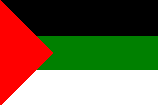
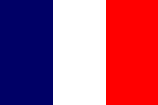

Arab Revolt Flag 1917 plus theFrench and Russian Tricolours (fotw)
CORNET (or CORNETTE or CORNUTE)
In largely British maritime usage a term, now increasingly obsolete, for a small triangular pennant (see also 'pennant 2)').
In British RN and some other usage a term, now almost wholly obsolete, for a swallow-tailed flag, particularly (but not exclusively) a signal flag (see also ‘signal flag’ and ‘swallow-tail(ed)’).
Alternative 17th/18th Century generic terms, now obsolete, referring to any small, swallow-tailed flag.
Alternative forms of ‘guidon’, now obsolete, as being the distinguishing flag of a cavalry regiment (see also ‘guidon 2)’).
A term, now obsolete, for lowest commissioned rank in the cavalry regiments of some countries (including those of the UK), being that rank responsible for carrying the regiment’s cornet or guidon.
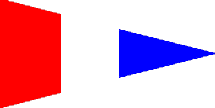
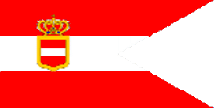
�Preceding Under Steam and Sail� in The Commercial Code of Signals c1860 (CS); Cornette/Pennant of a Senior Officer/Commodore, Austria then Austria-Hungary 1786 � 1894 (fame)
CORNSHEAF
In heraldry see ‘garbe’.
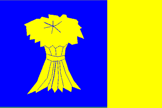

Flag and Arms of Reduzum, The Netherlands (fotw)
CORNUCOPIA
An ancient symbol of prosperity and now generally shown as a hollow, horn-shaped basket usually (but not invariably) filled to overflowing with various kinds of festive fruit and/ or vegetables etc � a horn of plenty.
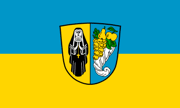
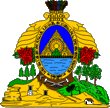
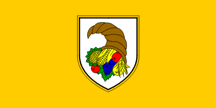
Flag of Nonnenhorn, Germany (fotw); National Arms of Honduras (fotw); Flag of Ivankovo, Croatia (fotw)
CORONATION FLAGS (or CORONATION BANNERS)
A term for those flags or banners (differing from the usual royal standard) which are prepared specifically for display at the installation (coronation, swearing-in or simple inauguration) of a monarch and often (but not exclusively) consisting of the relevant royal or national arms on a plain field – a “rijksvaandel”, “riksbanner”, �royal banner� or “banner of the realm” (see also ‘greater arms’ under ‘arms’, ‘installation flags’ and ‘royal standard(s) 1)’).
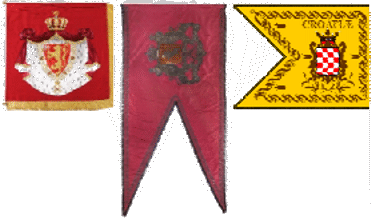
Coronation Flags (riksbanner), Norway 1906 and 1818 (official website); Flag of Croatia for the Coronation of Ferdinand V in Bratislava 1830 (fotw)
CORONET
- Generically on flags, a crown without a curved bar across the top that may be seen in a wide variety of shapes and circumstances - an open crown (see also ‘antique crown’, 'civic crown', ‘crown’, 'mural crown' and 'naval crown' and ‘provincial crown’).
- Specifically on flags, the term may be used when a hereditary ruler (or former hereditary ruler) is of a lesser rank than that of crowned monarch - a princely, arch-ducal or grand-ducal coronet (see also ‘electoral cap’).
- In English heraldry a crown without cross bar across the top as 1) above, but also a symbol of nobility whose exact design is dependent upon the rank of the person concerned (see also ‘mantle’).
[ ![[coronet]](http://www.crwflags.com/fotw/images/v/vxt-d4664.gif) ](../images/v/vxt-d4664.gif) [
](../images/v/vxt-d4664.gif) [ ![[coronet]](http://www.crwflags.com/fotw/images/v/vxt-d906c.gif) ](../images/v/vxt-d906c.gif) [
](../images/v/vxt-d906c.gif) [ ![[coronet]](http://www.crwflags.com/fotw/images/v/vxt-d4523.gif) ](../images/v/vxt-d4523.gif)
](../images/v/vxt-d4523.gif)
Flag of Nacimiento, Spain (fotw); Coronet of a Duke in English heraldry (Wikipedia); Flag of Vranov, Czechia (fotw)
Please note that the use of a cross-bar across the top to indicate royal status and to differentiate between a crown and a coronet is of comparatively recent date (in English usage from the reign of King Henry VII, 1485 � 1509).
CORPORATE FLAG
The distinguishing flag of a shore-based commercial concern as opposed to that of merchant marine company � a commercial flag/pennant (see also ‘house flag 1)’ and ‘logo’).
[ ![[Corporate flag]](http://www.crwflags.com/fotw/images/v/vxt-d3894.gif) ](../images/v/vxt-d3894.gif) [
](../images/v/vxt-d3894.gif) [ ![[Corporate flag]](http://www.crwflags.com/fotw/images/v/vxt-d1918.gif) ](../images/v/vxt-d1918.gif) [
](../images/v/vxt-d1918.gif) [ ![[Corporate flag]](http://www.crwflags.com/fotw/images/v/vxt-d2686.gif) ](../images/v/vxt-d2686.gif)
](../images/v/vxt-d2686.gif)
Flag of HSBC, UK (fotw); Flag of Citro�n, France (fotw); Flag of Avis, US (fotw)
CORPORATE LOGO
See ‘logo’.
[ ![[corporate logo example]](http://www.crwflags.com/fotw/images/v/vxt-d2774.gif) ](../images/v/vxt-d2774.gif)
](../images/v/vxt-d2774.gif)
Flag of Pan American Airways, US (fotw)
CORPORATION (or CORPORATE) BANNER
In largely UK usage, a type of processional banner whose symbolism relates to the corporate body of a town council or corporation, or to the community represented – see ‘banner 3)’.
CORPS FLAG
See ‘camp flag’.
See ‘branch of service flag 2)’.
[ ![[Corps flag]](http://www.crwflags.com/fotw/images/v/vxt-d1444.gif) ](../images/v/vxt-d1444.gif) [
](../images/v/vxt-d1444.gif) [ ![[Corps flag]](http://www.crwflags.com/fotw/images/v/vxt-d1445.gif) ](../images/v/vxt-d1445.gif)
](../images/v/vxt-d1445.gif)
Corps/Camp Flag of the Royal Armoured Corps, UK (Graham Bartram); Flag of the Corps of Engineers, US (fotw)
CORSAIR(S)
See ‘jolly roger 1)’ and ‘privateer(s)’.

Flag of Edward Lowe, Early 18th C (fotw)
CORSAIR ENSIGN
See ‘privateer ensign’ and ‘jolly roger 1)’.
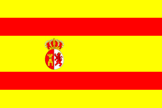
Corsair/Privateer Ensign, Spain 1820 (fotw)
